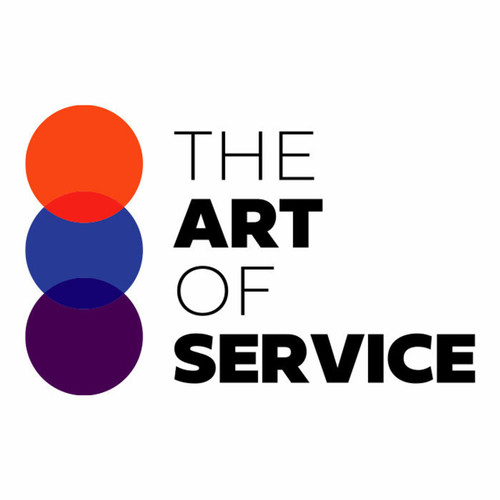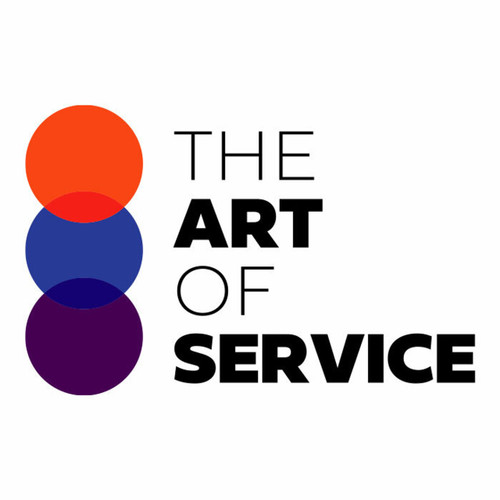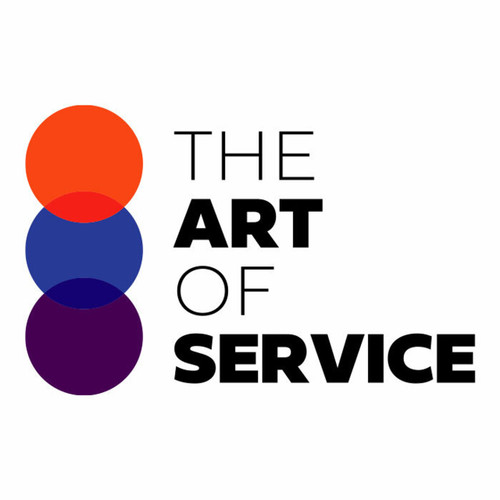Are you looking for a comprehensive and reliable resource to help your team handle difficult situations with customers? Look no further!
Our Knowledge Base is the ultimate solution for professionals who want to elevate their customer service game.
Say goodbye to struggling to come up with the right questions to ask in high-pressure scenarios.
Our dataset of 1547 prioritized requirements will guide you through every scenario based on urgency and scope.
This means you can handle any situation with confidence and efficiency, resulting in increased customer satisfaction and retention.
But that′s not all - our Knowledge Base also provides solutions tailored to your needs, giving you ready-to-use techniques and strategies to effectively manage emotions and deliver exceptional customer service.
Plus, with real-world case studies and use cases, you can see these methods in action and learn from successful examples.
Compared to other alternatives, our Handling Emotions and Customer Service Excellence dataset stands out as the most comprehensive and effective tool for professionals.
No more expensive training or complicated processes - our product is easy to use and DIY-friendly, making it a much more affordable option.
You may be wondering, how does this product differ from other similar resources? The answer is simple - our Knowledge Base is specifically designed for handling emotions and customer service excellence.
You won′t find a more targeted and thorough product that addresses these specific challenges.
Not only will you benefit from practical solutions, but you will also have access to in-depth research on handling emotions and achieving customer service excellence.
Stay ahead of the game by continuously improving your skills and knowledge in this crucial aspect of business.
And it′s not just for individuals - our Knowledge Base is also suitable for businesses of all sizes.
Improve overall organizational performance and create a more positive work environment by equipping your team with the necessary tools to handle emotions and provide exceptional customer service.
Still not convinced? Let′s talk about cost.
Our Knowledge Base is a cost-effective solution, saving you time, money, and resources.
And with our detailed product specifications, you can rest assured that you′re getting exactly what you need.
In conclusion, our Handling Emotions and Customer Service Excellence Knowledge Base is the game-changer your business needs to excel in the competitive world of customer service.
Don′t miss out on this opportunity to enhance your skills, improve customer satisfaction, and boost your bottom line.
Get started today and see the results for yourself!
Discover Insights, Make Informed Decisions, and Stay Ahead of the Curve:
Key Features:
Comprehensive set of 1547 prioritized Handling Emotions requirements. - Extensive coverage of 159 Handling Emotions topic scopes.
- In-depth analysis of 159 Handling Emotions step-by-step solutions, benefits, BHAGs.
- Detailed examination of 159 Handling Emotions case studies and use cases.
- Digital download upon purchase.
- Enjoy lifetime document updates included with your purchase.
- Benefit from a fully editable and customizable Excel format.
- Trusted and utilized by over 10,000 organizations.
- Covering: Brand Excellence, Digital Supply Chain, Empowering Employees, New Employee Orientation, Driving Excellence, Supplier Quality, Listening Skills, Customer Centric Approach, Escalation Management, Customer Service Culture, Voicemail Messages, Customer Acquisition Strategies, Continuous Improvement Communication, Customer Satisfaction, Ongoing Training, Customer Empathy Training, Service Response Time, Decision Making, Quality Function Deployment, Understanding Customer Needs, Inbound Call Management, Sales And Upselling, Defining Values, Held Calls, Customer Driven, Customer Feedback Management, Customer Relationship Enhancement, Efficiency Reporting, Service Desk Excellence, Group Fairness, Call Monitoring, Staff Motivation, Information Technology, Productivity Rates, Shingo Prize, Process Optimization Tools, Customer Driven Solutions, Up To Date Technology, Time Management, Service Recovery, Demand Variability, Customer Trends, Removing Barriers, Continuous Improvement, Resolving Customer Complaints, Productivity Tracking, Responsive Communication, Service Excellence, Defect Rates, Process Enhancements, Tailored Communication, Hierarchical Communication, Customer Focus, Digital Workflow Management, Service Speed, Long Term Partnerships, Stakeholder Communications, De Escalation Techniques, Influencing Skills, Voice of the Customer, Customer Success Strategies, Active Listening, Trust Building, Business Process Redesign, Service Delivery Improvement, Encouraging Diversity, Customer Engagement Tracking, Customer Experience Management, Process Complexity, Transportation Economics, Regulators Expectations, Communication Improvement, Transparent Culture, Customer Oriented, New Market Penetration, Handling Objections, Consistent Communication, Knowledge Of Products, Personalized Service, Handling Returns, Customer Service Training, Reacting To Challenges, Benchmarking And Best Practices, Efficient Resource Allocation, Customer Communication Strategies, Tone Of Voice, Negotiation Skills, Complaint Handling, Handling Emotions, Customer Complaints, Questioning Skills, Building Rapport, Stress Management, Customer Service Goals, Process Optimization Teams, Positive Language, Quality Control Culture, Urgency Management, Involvement Culture, Service Scalability, Customer Complaint Resolution, Service Desk Support, Scheduling Optimization, Human Rights Policies, Regulatory Compliance, Customer Service Metrics, Custom Workflows, Problem Solving Skills, Agent Training, Customer Trust, Face To Face Communication, Customer Service Excellence, Billing Accuracy, Customer service best practices implementation, Customer Complaint Management, Relationship Building, Customer Oriented Strategies, Customer Collaboration Tools, , Customer Service Skills, Quality Assurance, Real Time Customer Service, Customer Service Tools, Improve Customer Experience, Service excellence initiatives, Customer Service Strategy, Performance Excellence Framework, Customer Follow Up, Customer Service Management, Voice Analytics, Customer Discovery, Efficiency Optimization, Honesty And Transparency, Supplier Codes Of Conduct, Customer Experience Marketing, Proactive Communication, Operational Excellence Strategy, Customer Education Programs, Service Delivery, Cloud Center of Excellence, Customer Feedback Integration, Efficiency Metrics, Agent Empowerment, Clear Communication, Operational KPIs, Conflict Resolution, Product Knowledge, Customer Experience, Customer Retention, Managing Expectations, Customer Service Policy, Customer Persona Building, Automation In Customer Service, Customer Interaction Management, Customer Needs Alignment, Customer Perception Measurement, Customer Journey Improvement, Customer Interactions, Customer Alignment
Handling Emotions Assessment Dataset - Utilization, Solutions, Advantages, BHAG (Big Hairy Audacious Goal):
Handling Emotions
To improve emotion handling, practice self-awareness, identify triggers, and practice calm responses. Consider therapy or mindfulness techniques for added support. Choose reactions that align with your values and promote positive outcomes.
1. Active Listening: Pay full attention to customers, showing empathy and understanding.
Benefit: Builds trust and rapport.
2. Emotional Intelligence: Develop self-awareness and regulation of emotions.
Benefit: Improves decision-making and maintains professionalism.
3. Practice Empathy: Put yourself in customers′ shoes, understanding their perspective.
Benefit: Fosters a connection and promotes positive interactions.
4. Positive Language: Use positive and reassuring language in responses.
Benefit: Calms customers and diffuses tense situations.
5. Problem-Solving: Focus on solutions, not problems, to shift the conversation.
Benefit: Reduces customer frustration and accelerates issue resolution.
6. Training and Coaching: Regularly train and coach teams on emotion management.
Benefit: Enhances overall customer service and employee satisfaction.
CONTROL QUESTION: How do you become better at handling the emotions, and choosing the reactions to bad situations?
Big Hairy Audacious Goal (BHAG) for 10 years from now: A big hairy audacious goal for handling emotions and choosing reactions to bad situations in 10 years could be:
To become a globally recognized thought leader and practitioner in the field of emotional intelligence and regulation, having developed and implemented a comprehensive, evidence-based training program that has positively impacted the lives of over a million individuals, enabling them to effectively handle their emotions and make empowered choices in the face of adversity.
In order to achieve this goal, one could focus on the following areas:
1. Developing a deep understanding of emotional intelligence and regulation theories and research.
2. Building practical skills in emotional awareness, expression, and regulation through mindfulness, cognitive-behavioral techniques, and other evidence-based practices.
3. Creating and delivering engaging, interactive, and effective training programs for diverse audiences, including individuals, organizations, and communities.
4. Conducting and publishing original research on emotional intelligence and regulation interventions, outcomes, and best practices.
5. Collaborating with other experts and leaders in the field to advance the knowledge and application of emotional intelligence and regulation in various settings.
6. Leveraging technology, social media, and other platforms to reach and impact a wide audience, and to foster a global community of emotionally intelligent and resilient individuals.
Customer Testimonials:
"As a researcher, having access to this dataset has been a game-changer. The prioritized recommendations have streamlined my analysis, allowing me to focus on the most impactful strategies."
"I can`t express how impressed I am with this dataset. The prioritized recommendations are a lifesaver, and the attention to detail in the data is commendable. A fantastic investment for any professional."
"I am thoroughly impressed with this dataset. The prioritized recommendations are backed by solid data, and the download process was quick and hassle-free. A must-have for anyone serious about data analysis!"
Handling Emotions Case Study/Use Case example - How to use:
Case Study: Handling Emotions - Becoming Better at Managing Reactions to Bad SituationsSynopsis of Client Situation:
The client is a mid-sized software development firm facing difficulties in managing employee emotions and reactions during stressful situations, leading to decreased productivity and a negative work environment. Employees often react impulsively, leading to misunderstandings, conflicts, and missed opportunities to learn and grow from challenging situations.
Consulting Methodology:
To address this challenge, the consulting process involves the following methodology:
1. Assessment and situational analysis: Analyze the current organizational climate and conduct interviews, surveys, and focus groups with employees to understand the root causes of emotional instability. Utilize emotional intelligence assessment tools for a comprehensive understanding of the team′s emotional competencies.
2. Strategy development: Based on the assessment, develop a tailored emotional intelligence strategy that targets areas of improvement, incorporates best practices from academic literature, and aligns with the company′s culture and goals.
3. Training and skill development: Design and deliver workshops, webinars, and coaching sessions on emotional intelligence skill development, emphasizing emotional self-awareness, social awareness, self-regulation, motivation, and relationship management.
4. Implementation and reinforcement: Ensure ongoing support and implementation through the creation of accountability mechanisms, performance management, and continuous improvement processes. Develop an internal network of champions and advocates for emotional intelligence to encourage sustainability.
5. Measurement and evaluation: Regularly evaluate progress through key performance indicators (KPIs) and other metrics, such as pre- and post-training assessments, employee satisfaction surveys, and organizational health indices.
Deliverables:
1. Emotional Intelligence assessment report for each employee.
2. Customized emotional intelligence strategy and training plan for the organization.
3. Emotional intelligence training materials, including presentations, job aids, and self-assessments.
4. Emotional intelligence coaching sessions for key employees and managers.
5. Evaluation framework with KPIs for measuring progress.
Implementation Challenges:
Implementing a comprehensive emotional intelligence program may encounter challenges related to the following areas:
1. Resistance to change from employees and management.
2. Resource constraints (time, budget, and personnel) to implement and maintain the program.
3. Difficulties aligning the emotional intelligence initiative with the company′s existing organizational culture.
4. Ensuring employees′ and managers′ commitment to ongoing training and skill development.
5. Employee turnover and attrition may interrupt long-term progress and the ability to measure results.
KPIs and Management Considerations:
Key performance indicators for the emotional intelligence program may include:
1. Pre- and post-training assessment scores measuring improvements in employees′ emotional intelligence.
2. Employee satisfaction surveys and organizational health indices.
3. Reduction in workplace conflicts and disciplinary incidents.
4. Increased productivity, creativity, and innovation.
5. Decreased absenteeism and turnover rates.
To ensure the success of the program, management should consider:
1. Aligning the emotional intelligence initiative with the company′s vision, mission, and values.
2. Securing executive sponsorship and leadership support at all levels of the organization.
3. Designating a dedicated internal project manager to oversee the implementation and monitoring of the program.
4. Allocating dedicated time, budget, and resources to develop, deliver, and sustain emotional intelligence training.
5. Establishing a supportive and collaborative learning culture where employees feel encouraged to express and manage their emotions.
Citations:
* Goleman, D., Boyatzis, R. E., u0026 McKee, A. (2013). Primal leadership: Unleashing the power of emotional intelligence. Harvard Business Review Press.
* Cherniss, C. (2010). The business case for emotional intelligence. Consulting Psychology Journal: Practice and Research, 62(2), 140-144.
* Brackett, M. A., Rivers, S. E., u0026 Salovey, P. (2011). Emotional intelligence: Key readings on measurement and assessment. The Guilford Press.
* Côté, S., u0026 Miners, C. T. (2006). Professional competence in the 21st century: The role of emotional intelligence. Canadian Journal of Counselling, 40(2), 93-106.
* Cooper, C. D., u0026 Quick, J. C. (Eds.). (2017). Managing stress in the public sector: A practical guide for human service professionals (3rd ed.). Routledge.
Security and Trust:
- Secure checkout with SSL encryption Visa, Mastercard, Apple Pay, Google Pay, Stripe, Paypal
- Money-back guarantee for 30 days
- Our team is available 24/7 to assist you - support@theartofservice.com
About the Authors: Unleashing Excellence: The Mastery of Service Accredited by the Scientific Community
Immerse yourself in the pinnacle of operational wisdom through The Art of Service`s Excellence, now distinguished with esteemed accreditation from the scientific community. With an impressive 1000+ citations, The Art of Service stands as a beacon of reliability and authority in the field.Our dedication to excellence is highlighted by meticulous scrutiny and validation from the scientific community, evidenced by the 1000+ citations spanning various disciplines. Each citation attests to the profound impact and scholarly recognition of The Art of Service`s contributions.
Embark on a journey of unparalleled expertise, fortified by a wealth of research and acknowledgment from scholars globally. Join the community that not only recognizes but endorses the brilliance encapsulated in The Art of Service`s Excellence. Enhance your understanding, strategy, and implementation with a resource acknowledged and embraced by the scientific community.
Embrace excellence. Embrace The Art of Service.
Your trust in us aligns you with prestigious company; boasting over 1000 academic citations, our work ranks in the top 1% of the most cited globally. Explore our scholarly contributions at: https://scholar.google.com/scholar?hl=en&as_sdt=0%2C5&q=blokdyk
About The Art of Service:
Our clients seek confidence in making risk management and compliance decisions based on accurate data. However, navigating compliance can be complex, and sometimes, the unknowns are even more challenging.
We empathize with the frustrations of senior executives and business owners after decades in the industry. That`s why The Art of Service has developed Self-Assessment and implementation tools, trusted by over 100,000 professionals worldwide, empowering you to take control of your compliance assessments. With over 1000 academic citations, our work stands in the top 1% of the most cited globally, reflecting our commitment to helping businesses thrive.
Founders:
Gerard Blokdyk
LinkedIn: https://www.linkedin.com/in/gerardblokdijk/
Ivanka Menken
LinkedIn: https://www.linkedin.com/in/ivankamenken/







